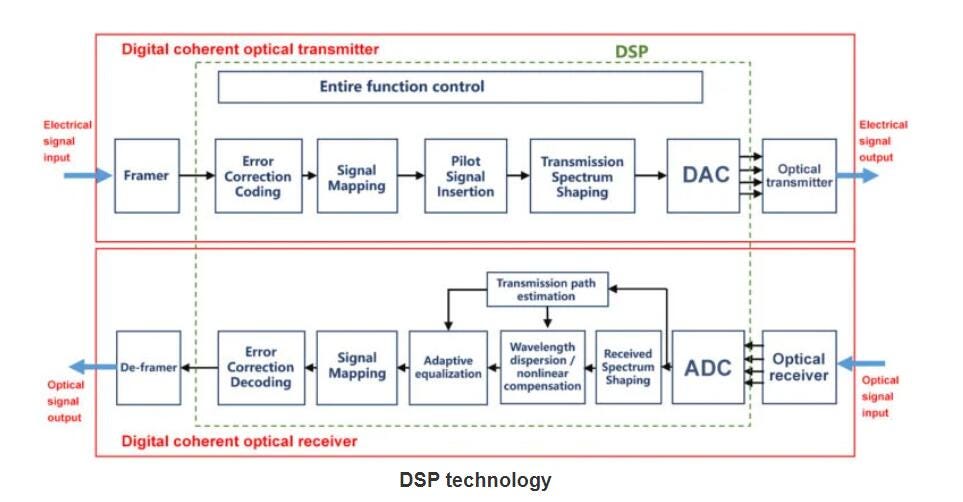As mentioned earlier, coherent optical communication mainly utilizes two key technologies, namely coherent modulation and heterodyne detection. Let’s first look at coherent modulation on the optical transmitter side. In the backward IM-DD (Intensity Modulation-Direct Detection) system, only intensity (amplitude) modulation can be used to modulate the light wave by changing the laser intensity through current to generate 0 and 1.

Direct modulation
Direct modulation is very simple, but it’s with a weak ability and many problems. However, in a coherent optical communication system, in addition to amplitude modulation of light, external modulation can also be used to perform frequency modulation or phase modulation, such as PSK, QPSK, and QAM. Additional modulation methods not only increase the information-carrying capacity (a single symbol can represent more bits) but also are suitable for flexible engineering applications.
The following is a schematic diagram of an external modulation:
Optical Transmitter (Coherent Modulation)

As shown in the figure, at the transmitting end, the external modulation method is adopted, and the IQ modulator based on the Mach-Zehnder modulator (MZM) is used to realize the high-order modulation format, and the signal is modulated on the optical carrier, and sent out.
It is the key link when entering the receiving end. First, a laser signal generated by local oscillation (local oscillator light) is used to mix with the input signal light in an optical mixer to obtain an intermediate frequency signal whose frequency, phase, and amplitude change according to the same rules as the signal light.

Optical receiver (heterodyne detection)

An enlarged version of the optical receiver structure
In a coherent optical communication system, the size of the output photocurrent after coherent mixing is proportional to the product of the signal optical power and the local oscillator optical power. Since the power of the local oscillator light is much higher than the power of the signal light, the output photocurrent is greatly increased, and the detection sensitivity is also improved.
In other words,non-coherent optical communication uses a lot of amplifiers to continuously relay and amplify the signal during the transmission process, while the essence of coherent optical communication is to mix and amplify the weak arriving signal directly at the receiving end.
After mixing, detection is performed with a balanced receiver. Coherent optical communication can be divided into heterodyne detection, intradyne detection, and homodyne detection according to the relationship between the frequency of the local oscillator optical signal and the signal optical frequency.

Classifications of coherent optical communication
In the coherent optical communication of heterodyne detection, the intermediate frequency signal is obtained by the photoelectric detector. The second demodulation is also required before it can be converted into a baseband signal. Homodyne and intradyne detection bring less noise and reduce the power overhead of subsequent digital signal processing and the requirements for related devices, so they are most commonly used. In homodyne detection coherent optical communication, the optical signal is directly converted into a baseband signal after passing through a photoelectric detector without secondary demodulation. However, it requires that the frequency of the local oscillator light and the signal light frequency be strictly matched, and the phase locking of the local oscillator light and the signal light is required.
Next, is the digital signal processing(DSP) link of great importance.

Digital Signal Processing(DSP)
Distortion occurs when an optical signal is transmitted in a fiber optic link. DCP technology takes advantage of the easy-handle characteristic of digital signals to combat and compensate for distortion, and reduce the impact of distortion on the system bit error rate. It has created the digital era of optical communication systems and become an important support for coherent optical communication technology. DSP technology can be not only applied to receivers, but also to transmitters.
As shown below:
digital signal processing(DSP) technologyDSP technology

Digital to analogue and analogue to digital

As can be seen from the above figure, DSP technology performs various signal compensation processing, such as chromatic dispersion compensation and polarization mode dispersion compensation (PMD).

Various Compensation and Estimation of DSP

The traditional non-coherent optical communication performs dispersion compensation and other functions through optical path compensation devices, whose compensation effect is far inferior to that of the DSP. The introduction of DSP technology simplifies the system design, saves cost, and eliminates the original dispersion compensation module (DCM) or dispersion compensation fiber in the system, which makes the link design of long-distance transmission simpler. With the development of DSP, more algorithms and functions are added continuously, such as nonlinear compensation technology and multi-code modulation and demodulation technology.

After DSP processing, the final electrical signal is output. Next, we review the whole process through a case of 100G coherent transmission.

The specific process is as follows:
1. After digital signal processing and digital-to-analog conversion, the 112Gbps signal stream, after entering the optical transmitter, undergoes “serial-parallel” conversion and becomes 4 channels of 28Gbps signals;
2. The signal emitted by the laser becomes an optical signal polarized in two vertical directions of x and y through the polarization beam splitter;
3. Through the high-order modulator composed of the MZM modulator, QPSK high-order modulation is performed on the optical signal in the x and y polarization directions;
4. The modulated polarized light signal is combined with an optical fiber through a polarization combiner for transmission;
5. After receiving the signal, the receiving end separates the signal into two vertical polarization directions of X and Y;
6. Through coherent detection and reception, the X and Y vertically polarized signals become current/voltage signals;
7. Through ADC conversion, the current and voltage signals are turned into digital code streams such as 0101…;
8. Through digital signal processing, the interference factors such as dispersion, noise, and nonlinearity are removed, and the 112Gbps telecommunication number stream is restored, and it’s the end.
HTF can help you design coherent 400G/200G/100G DWDM/OTN solution, DWDM Single lamda 100G/200G/400G Dual fiber/Single fiber Ultra long distance transmission.



没有评论:
发表评论